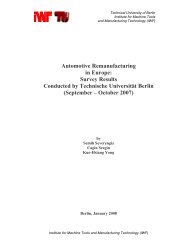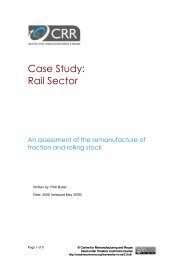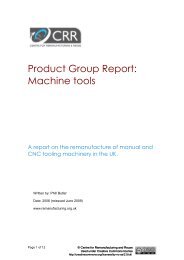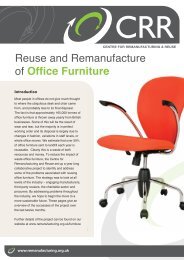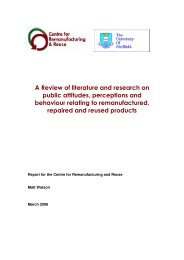Report on the remanufacturing of refrigerated display cabinets
Report on the remanufacturing of refrigerated display cabinets
Report on the remanufacturing of refrigerated display cabinets
You also want an ePaper? Increase the reach of your titles
YUMPU automatically turns print PDFs into web optimized ePapers that Google loves.
©Centre for Remanufacturing & Reuse 2009<br />
1.2 What is <strong>remanufacturing</strong><br />
Remanufacturing is defined as returning a used product, via a manufacturingtype<br />
process, to at least its original performance with a warranty that is equivalent<br />
or better than that <strong>of</strong> <strong>the</strong> newly manufactured product. A remanufactured product<br />
should be practically indistinguishable from a new product from <strong>the</strong> purchasers‟<br />
point <strong>of</strong> view. The process <strong>of</strong> <strong>remanufacturing</strong> involves disassembling a product,<br />
inspecting and replacing worn parts and c<strong>on</strong>sumables, applying a surface finish,<br />
reassembling <strong>the</strong> product and thoroughly testing it to ensure that <strong>the</strong> product<br />
complies with original performance specificati<strong>on</strong>s. Remanufacturing is an<br />
important, but under-exploited, method <strong>of</strong> reducing our envir<strong>on</strong>mental burden,<br />
and is estimated to be worth at least £5bn to <strong>the</strong> UK ec<strong>on</strong>omy. 2<br />
It is important to state that <strong>the</strong>re is a comm<strong>on</strong> misc<strong>on</strong>cepti<strong>on</strong> that <strong>remanufacturing</strong><br />
and recycling are syn<strong>on</strong>ymous. Recycling is a process for reusing materials:<br />
During recycling <strong>the</strong> functi<strong>on</strong> or physical form <strong>of</strong> <strong>the</strong> recycled product and its<br />
comp<strong>on</strong>ents is lost through physical or chemical destructi<strong>on</strong>. Remanufacturing is<br />
a process for reusing products, where <strong>the</strong> form and functi<strong>on</strong> <strong>of</strong> a device or its<br />
sub-comp<strong>on</strong>ents are retained to <strong>the</strong> fullest extent 3 . A simple example is a glass<br />
bottle: If it is washed, has a new label affixed to it, refilled and sealed <strong>the</strong> product<br />
form and functi<strong>on</strong> have been retained, and could be c<strong>on</strong>sidered as having been<br />
remanufactured. If <strong>the</strong> bottle is crushed melted and reformed into a glass bottle<br />
<strong>on</strong>ly <strong>the</strong> material has been preserved and should be c<strong>on</strong>sidered as recycling.<br />
Remanufacturing a product removes <strong>the</strong> need to use virgin materials and<br />
c<strong>on</strong>sume energy in its manufacture. Broadly speaking, <strong>the</strong> remanufacture <strong>of</strong> a<br />
product produces fewer carb<strong>on</strong> dioxide emissi<strong>on</strong>s than manufacturing from new.<br />
Also, because <strong>the</strong> embodied energy in <strong>the</strong> c<strong>on</strong>structi<strong>on</strong> <strong>of</strong> <strong>the</strong> product is retained,<br />
<strong>remanufacturing</strong> involves a lower carb<strong>on</strong> footprint than scrapping and recycling<br />
materials and – all o<strong>the</strong>r factors being equal – is a preferential opti<strong>on</strong> to recycling.<br />
The excepti<strong>on</strong> to this occurs most <strong>of</strong>ten where <strong>the</strong> product c<strong>on</strong>sumes energy in<br />
its operati<strong>on</strong> and where energy efficiency improvements in new product design<br />
have reduced <strong>the</strong> overall energy c<strong>on</strong>sumpti<strong>on</strong> <strong>of</strong> a device whilst in use. Under<br />
such circumstances, savings made through delivering a remanufactured product<br />
may be lost through <strong>the</strong> inefficiencies <strong>of</strong> persisting with <strong>the</strong> use <strong>of</strong> an older<br />
design. This issue can be eliminated if a remanufactured unit can be upgraded to<br />
attain <strong>the</strong> energy efficiency standards <strong>of</strong> a new unit.<br />
Remanufacturing is an important and integral aspect <strong>of</strong> numerous UK sectors. Its<br />
prevalence and applicati<strong>on</strong> are dictated by several factors including cost <strong>of</strong><br />
original product, speed <strong>of</strong> technological advance and <strong>the</strong> ease with which a<br />
product can be disassembled and remanufactured. Industries such as aerospace<br />
are exemplars, in which <strong>remanufacturing</strong> is built into <strong>the</strong> business models <strong>of</strong> all<br />
comp<strong>on</strong>ent manufacturers and is seen as an essential way to reduce costs. The<br />
aerospace example also counteracts c<strong>on</strong>cerns that <strong>the</strong> remanufactured product<br />
2 Remanufacturing in <strong>the</strong> UK, 2004, Oakdene Hollins Ltd<br />
3 Parts or comp<strong>on</strong>ents that are unfit for reuse may be sent for recycling, recovery or landfill as <strong>the</strong> next best opti<strong>on</strong>.<br />
Page 10 <strong>of</strong> 38





